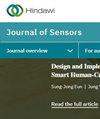A Feasibility Study on the Efficacy of Functional Near-Infrared Spectrometry (fNIRS) to Measure Prefrontal Activation in Paediatric HIV
IF 1.4
4区 工程技术
Q3 ENGINEERING, ELECTRICAL & ELECTRONIC
引用次数: 0
Abstract
Human immunodeficiency virus (HIV) infection is associated with disturbed neurotransmission and aberrant cortical networks. Although advances in the imaging of brain microarchitecture following neuroHIV has added to our knowledge of structural and functional changes associated with HIV, no data exists on paediatric HIV using optical neuroimaging techniques. This study investigated the feasibility of optical neuroimaging in paediatric HIV using functional near-infrared spectrometry (fNIRS). We measured prefrontal brain activation while participants executed a sustained attention task. We specifically tested whether patients living with HIV and study controls could perform the study protocol and whether we could measure the typical fNIRS haemodynamic response associated with neuronal activity. Eighteen participants (10 HIV participants, mean age: 13.9, SD = 1.66 years; 8 controls, mean age: 14.8, SD = 1.28 years), matched for sex, grade, and socio-economic status, were included in the study. All participants completed the Stroop colour word test (SCWT). Oxygenated haemoglobin concentration and the deoxygenated haemoglobin signal were recorded from the dorsolateral prefrontal cortex and the frontopolar area (FA) using fNIRS. The control group performed significantly better in terms of reaction time on the congruent and incongruent condition (congruent: t (16) = −3.36, : incongruent: ). A pooled group analysis of the sample indicated significant activation in the DLPF and FA to the congruent condition of the SCWT (). Although cortical activation was noted in the DLPF and the FA in each of the groups when analysed independently, this neural activation did not reach statistical significance. The results show promise that fNIRS techniques are feasible for assessing prefrontal cortical activity in paediatric HIV. Future studies should seek to reduce the signal-to-noise ratio and consider inter-individual variability when measuring prefrontal activation in paediatric samples.用功能性近红外光谱法(fNIRS)测量儿童艾滋病患者前额叶激活情况的可行性研究
人类免疫缺陷病毒(HIV)感染与神经传递紊乱和皮质网络异常有关。虽然神经HIV感染后大脑微观结构成像技术的进步增加了我们对与HIV相关的结构和功能变化的了解,但目前还没有使用光学神经成像技术对儿科HIV进行成像的数据。本研究利用功能性近红外光谱仪(fNIRS)对儿科艾滋病病毒的光学神经成像进行了可行性研究。我们测量了参与者执行持续注意力任务时前额叶大脑的激活情况。我们特别测试了艾滋病病毒感染者和研究对照组是否能够执行研究方案,以及我们是否能够测量与神经元活动相关的典型 fNIRS 血流动力学反应。研究共纳入了 18 名参与者(10 名 HIV 感染者,平均年龄:13.9 岁,SD = 1.66 岁;8 名对照组,平均年龄:14.8 岁,SD = 1.28 岁),他们的性别、年级和社会经济状况均匹配。所有参与者都完成了斯特罗普颜色词测试(SCWT)。研究人员使用 fNIRS 记录了背外侧前额叶皮层和前额极区(FA)的氧合血红蛋白浓度和脱氧血红蛋白信号。对照组在同义和非同义条件下的反应时间表现明显更好(同义:t (16) = -3.36;非同义:)。对样本进行的集合分组分析表明,在 SCWT 的一致条件下,DLPF 和 FA 有明显激活()。虽然在对每组样本进行独立分析时,发现 DLPF 和 FA 的皮质激活,但这种神经激活并没有达到统计学意义。研究结果表明,fNIRS 技术可用于评估儿科艾滋病患者的前额叶皮质活动。未来的研究应设法降低信噪比,并在测量儿科样本的前额叶激活时考虑个体间的差异性。
本文章由计算机程序翻译,如有差异,请以英文原文为准。
求助全文
约1分钟内获得全文
求助全文
来源期刊

Journal of Sensors
ENGINEERING, ELECTRICAL & ELECTRONIC-INSTRUMENTS & INSTRUMENTATION
CiteScore
4.10
自引率
5.30%
发文量
833
审稿时长
18 weeks
期刊介绍:
Journal of Sensors publishes papers related to all aspects of sensors, from their theory and design, to the applications of complete sensing devices. All classes of sensor are covered, including acoustic, biological, chemical, electronic, electromagnetic (including optical), mechanical, proximity, and thermal. Submissions relating to wearable, implantable, and remote sensing devices are encouraged.
Envisaged applications include, but are not limited to:
-Medical, healthcare, and lifestyle monitoring
-Environmental and atmospheric monitoring
-Sensing for engineering, manufacturing and processing industries
-Transportation, navigation, and geolocation
-Vision, perception, and sensing for robots and UAVs
The journal welcomes articles that, as well as the sensor technology itself, consider the practical aspects of modern sensor implementation, such as networking, communications, signal processing, and data management.
As well as original research, the Journal of Sensors also publishes focused review articles that examine the state of the art, identify emerging trends, and suggest future directions for developing fields.
 求助内容:
求助内容: 应助结果提醒方式:
应助结果提醒方式:


